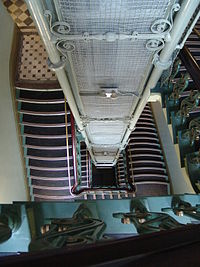- Chief Secretary's Building
-
The Chief Secretary’s Building (originally the Colonial Secretary's Building) is an historic Sydney landmark located at 121 Macquarie Street, 65 Bridge Street and 44-50 Phillip Street. The sandstone building was the seat of colonial administration, has been used continuously by the Government of New South Wales, and even today holds the office of the Governor of New South Wales. Its main occupant is the Industrial Relations Commission of New South Wales; several of the larger rooms are now courtrooms.
“ ...(this) pile of a building like a veritable 'poem in stone' adorns the northern portion of Macquarie Street. ” —Illustrated Sydney News, 28 February 1891
Contents
Architecture
Constructed 1873-1880, the building was designed by colonial architect James Barnet. Its style has been called "Venetian Renaissance" as well as Victorian Free Classical. A fifth floor and dome were added in the 1890s by Barnet’s successor Walter Liberty Vernon in the Victorian Second Empire style,[1] as well as an extension south at 50 Phillip Street. Barnet resented the additions, which lessened the resemblance to his model, the 16th Century Palazzo Farnese in Rome, completed by Michelangelo after Farnese became Pope Paul III. The dome was originally covered in aluminium in 1895-1896, one of the earliest such uses of this metal in the world.
The building features nine life-size statues (six external and three internal) placed according to the administrative function of three parts of the building. The entrances on three streets are labelled in sandstone, directing visitors to the appropriate section.
- The prestigious 121 Macquarie Street entrance is labelled "Colonial Secretary". He occupied the North-East corner office on the First Floor (at the time the top floor, now called Level 3). Sandstone sculptures in the building's exterior personify Mercy, Justice, and Wisdom (top to bottom). Inside stands a marble statue of Queen Victoria.
- The 65 Bridge Street (central) ground floor entrance, one level below, is labelled "Public Entrance". Inside stands a female figure representing New South Wales, a merino at her foot. The NSW Badge, adopted in 1876, is sculpted above in the pediment.[2]
- The 44 Phillip Street entrance is labelled "Secretary for Works" and features a bust of Queen Victoria. The Minister for Public Works had his office in the North-West corner. The external statues personify Art, Science, and Labour. The internal statue on this side is of Edward VII when Prince of Wales.
The internal Carrara marble statues are by Giovanni Giuseppe Fontana. He was born in Italy (1821) but lived and worked in England, dying in London in December 1893. The external sandstone statues are by Achille Simonetti (Rome 1838 - Birchgrove 1900), who in 1874 established a large studio in Balmain.[3]
The interior features Australian Red Cedar and ornate tiles, plaster ceilings and cornices.
Historical significance
The building's design and furnishings reflect in large part the taste of the first Colonial Secretary, Sir Henry Parkes.
The Executive Council Chamber (originally known as the Cabinet Room) was the venue for several meetings that led to Federation, including the Australasian Federal Convention of 1891.[4] The room is very well preserved, with period furniture, paintings of a young Queen Victoria and James Cook, and bronzes of several British Prime Ministers including Palmerston. Some of the objects on display were acquired from the Sydney International Exhibition (1879).
Extensive restorations between 1988 and 2005 were performed with a degree of care that set new standards.[5] It is open to the public; several historical displays interpret the building's history, and the glass lift shafts allow archaeological viewing of the construction.
References
External links
- NSW Heritage Statement of Significance
- "Entry AHD1824". Australian Heritage Database. Department of Sustainability, Environment, Water, Population and Communities. http://www.environment.gov.au/cgi-bin/ahdb/search.pl?mode=place_detail;place_id=1824.
- Images from the National Library of Australia's Picture Australia
Coordinates: 33°51′49″S 151°12′44″E / 33.8635°S 151.2123°E
Categories:- Buildings and structures in Sydney
Wikimedia Foundation. 2010.


